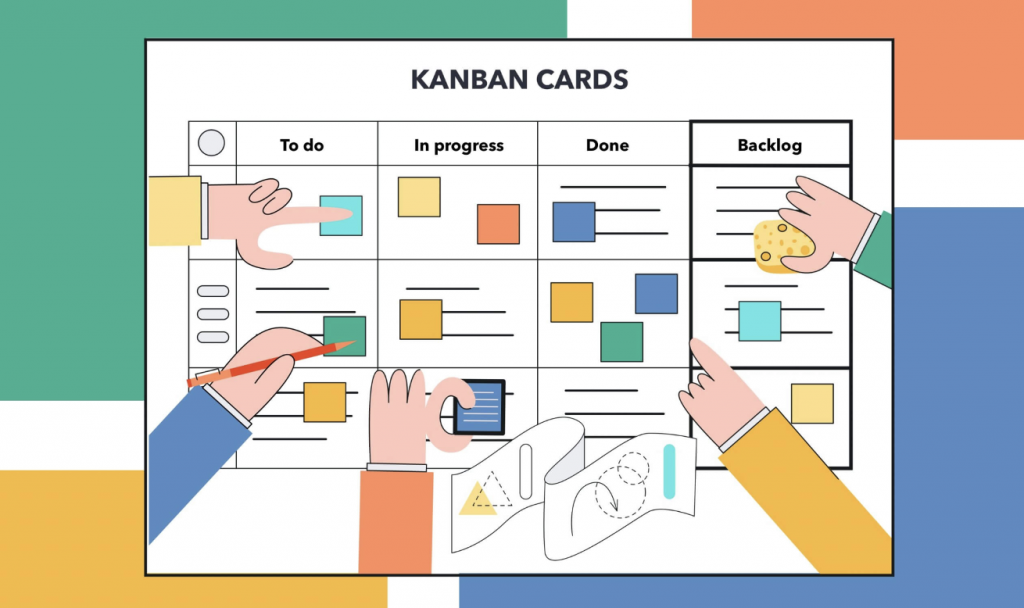
In a fast-paced world, we have more and more to do. There are distractions everywhere, and sometimes it can be a challenge to focus on the task at hand. To keep yourself, or your teams from getting overwhelmed, here are different methods you can apply to increase productivity at the office.
Table of Contents
Kanban

The Kanban method originated in Japan, and lets you divide your work into different sections. Tasks that you need to do, tasks that you are currently doing, and tasks that are done. You would use some sort of board to do this, a physical one or a digital one, and put your tasks on cards that you move around on the board.
It can become a sort of gamification, pulling a card from one section of the board to the next. A concrete way of seeing that you accomplished something you had set out to do.
The Kanban method allows you to get a clear view of the tasks and projects you are working on, as well as how you are spending your time. You can clearly see how the cards are moving on the board, and make changes and adjustments accordingly in order to increase productivity.
A digital tool for using the Kanban method is Trello. Trello is a platform that can help you organize your tasks in accordance with the Kanban method, and they have several analytics tools that can help you learn more about your workflow and how to work with the data, in order to optimize your productivity. Using Trello, your Kanban board can also be converted into a to-do list or even an Instagram content calendar that you may include your hashtag research in!
SMART Goals
SMART goals is a way to make goal-setting more concrete. But even though this productivity method can prove to be very effective, only 3% of adults have measurable goals. Just think of what we all could achieve if we just were SMART about our goal setting. Your goals need to be:
- Specific
- Measurable
- Achievable
- Relevant
- Time-bound
Your goals need to be specific, with little to no room for interpretation. They need to be well defined and clear. It isn’t enough to say that you want to get into shape. You need to make a goal to take a walk every day, or to go to the gym every Tuesday.
They also need to be measurable. Numbers are your friend here, they help you see if you have stayed on track. I want to sell more products in my store is not measurable. I want to increase sales by 15% by March of next year is much easier to have as a foundation to find out if you have reached your goal. Another example could be to increase your website conversions by 2% through implementing social proof tactics, such as testimonials, video popups, and so on.
The next step is to make the goal achievable. You need to know if you have what it takes to even reach it. Do you have all the resources necessary, and can you find examples of other people achieving similar goals before you?
Are your goals relevant? Have a look at the time frame you have set, and the resources at your disposal. Also make sure the goal serves you in a way that suits your life or your business. Will it be a worthwhile goal given whatever circumstance you or your business are in? Are you even the right person to work towards this goal?
Finally, your goal needs to be time-bound. Meaning that you need a deadline, otherwise you might never achieve it. Having a set end date can help you prioritize what you work on and prevent your long-term goals from being forgotten in the midst of all the smaller, every-day goals you might have.
The SMART goal setting method can help bring clarity and help you and your team to focus on what’s important.
Time Blocking
It can be easy to spend an entire work day just aimlessly going around doing tasks that really didn’t need to be done at that exact moment. If you find yourself having only been productive during a few short hours in an eight-hour workday, time blocking could be worth a try.
The basic idea is that you plan out your day carefully, every single task, in time blocks. This aims to create focus, and give you and your team very clear guidelines as to what task to focus on. If you know that your time for answering emails is between eight and nine o’clock in the morning, then you might not get distracted from other tasks throughout the day. Also, by keeping such a full calendar, you might not be as likely to take on tasks that aren’t relevant to your work. By blocking off sections of time you might find that there is less room for interruptions. Studies have shown that workers are interrupted every three minutes and five seconds, and then it takes time to get your focus back.
Within time blocking there is the method of single-tasking. By focusing on one thing at a time, your productivity actually goes up. Multitasking isn’t nearly as effective. In fact, your productivity goes down by 20% if you juggle too many tasks at a time.
Time blocking isn’t just for work. You need to also schedule in your breaks, preventing yourself from wasting time, just scrolling through social media. Having such a ‘strict’ approach to your day, might help you to not lose sight of what’s important to you in your workday.
The Weekly Review
Working in teams where everyone does their own, there is the risk of not being on the same page at any given time. To make sure your team are staying productive and reach the goals you have set out, the productivity method that can help you is The Weekly Review.
Giving you an overview of the tasks that have been done during the week can be useful for getting the big picture. If you or someone in your team falls off track, the weekly review can be a tool for regrouping and staying on task. By going over what has been accomplished during the week, you can also see what hasn’t been done. Successes and failures can be analyzed in order to see how you are going to be working in the next week. Increasing productivity is easier if you know what is actually happening in any given project, and if you keep workers from getting too overwhelmed.
In conclusion, if you want to increase the productivity of your team, or your own productivity as an employee or a manager, there are plenty of methods to choose from. Finding a way that works for the individual and the team at large can be tricky, but most of the productivity methods out there are simple and straightforward.
But by having knowledge of what goes on in your company or in your day to day work life, it gets that much easier to keep your productivity up.